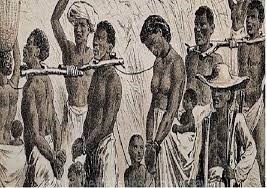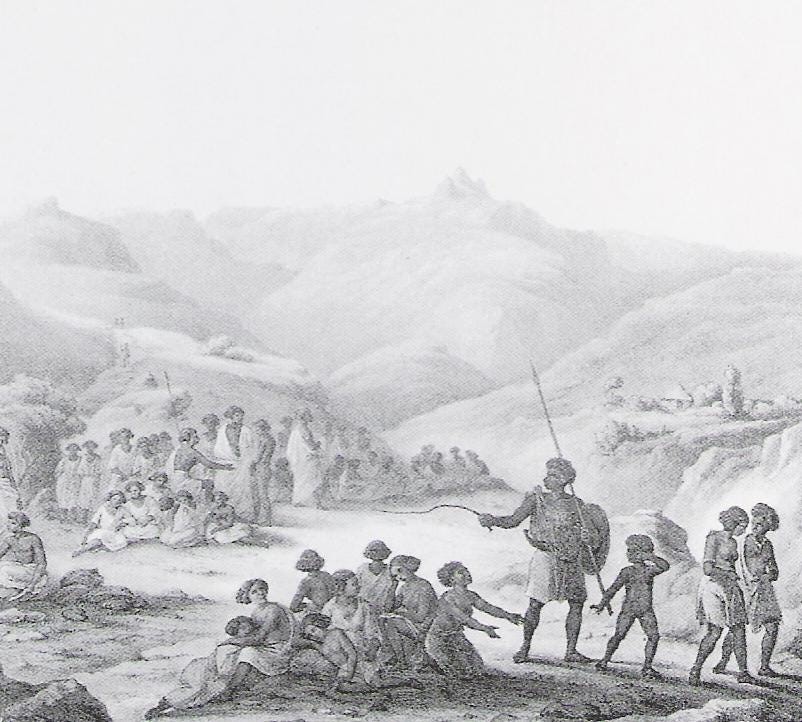Pata Sakai’s story is not just about the astonishing number of children he fathered but also a window into the brutal realities of slavery in the antebellum South. Born in the early 19th century, Sakai’s life was marred by the institution of slavery. His existence unfolded against a backdrop of oppression, cruelty, and dehumanisation, yet he managed to leave behind a legacy that is nothing short of astounding.
Pata Sakai was born into a life of bondage. The very concept of freedom was alien to him from his earliest years. As a slave, his destiny was determined by the whims and desires of his masters, who regarded him as property, not as a human being. Pata Sakai was born into a world that denied him his most fundamental rights and subjected him to a life of servitude.
It is crucial to recognise that the institution of slavery in the United States was not monolithic. The experiences of enslaved people varied greatly based on factors such as their location, the temperament of their owners, and the type of labor they were forced to perform. Pata Sakai’s life, for instance, was shaped by the peculiar institution as it existed in the Deep South, where cotton was king and the demand for labor was insatiable.
Pata Sakai lived on a large plantation, one of many that dotted the landscape of the Southern states. These plantations were economic powerhouses, producing vast quantities of cotton, tobacco, and other crops, thanks to the forced labor of enslaved people. The plantation system was a hierarchical structure where power was concentrated in the hands of the plantation owner and overseers. Enslaved people, like Pata Sakai, toiled relentlessly, enduring harsh working conditions and brutal punishments.
The role of enslaved men like Sakai in this system was multifaceted. They were forced to work in the fields, cultivate crops, and perform various manual labor tasks. Simultaneously, they were subjected to the sexual exploitation of their female counterparts. Enslaved women were vulnerable to the sexual advances of their masters and overseers, and the resulting offspring were born into a life of bondage, inheriting the status of their enslaved mothers.
Pata Sakai’s story stands out for a remarkable reason. In an era where the majority of enslaved individuals had no control over their reproductive destinies, Sakai was different. He managed to assert a degree of agency within the constraints of his enslaved existence. While he was compelled to engage in sexual relationships dictated by his masters, he also had consensual relationships with enslaved women on the plantation. In this sense, Sakai’s ability to father a large number of children was not entirely due to coercion but also stemmed from his own choices.
It’s essential to acknowledge that these relationships, even if consensual in some cases, were always under the overarching shadow of slavery’s coercive and oppressive environment. The power dynamics inherent in the master-slave relationship continued to affect the lives of these individuals, even when some degree of agency could be exercised.

The legacy of Pata Sakai is complex and multifaceted. On the one hand, it is a testament to his resilience and ability to navigate the brutal world of slavery, where his every action and desire were tightly controlled. On the other hand, it highlights the tragic circumstances under which his children were born. The offspring of enslaved women and men like Sakai faced the harsh realities of bondage from the moment they entered the world. They were denied the most basic human rights and forced to endure a life of servitude.
As we consider the enormity of Sakai’s legacy, it’s crucial to remember that each of his 249 children had a unique experience and journey. Their lives were marked by the cruelty of slavery but also characterised by their own strengths and the communities they formed within the confines of bondage.
The mid-19th century marked a period of significant change in the United States. The abolitionist movement gained momentum, challenging the institution of slavery and advocating for the emancipation of enslaved people. As the movement grew, the moral and economic foundations of slavery came under scrutiny, and the nation inched closer to a reckoning with its past.
Pata Sakai’s life spanned a period of immense social and political transformation. While he continued to father children during these tumultuous times, the winds of change were beginning to blow. The Civil War, which erupted in 1861, had a profound impact on the institution of slavery, as the Confederate states fought to preserve their way of life, built upon the forced labor of enslaved people.
One of the most pivotal moments in the history of American slavery came on January 1, 1863, when President Abraham Lincoln issued the Emancipation Proclamation. This executive order declared the freedom of all enslaved people in Confederate-held territory. While it did not instantly grant freedom to all enslaved individuals, it marked a crucial step in the direction of abolition and sent a powerful message about the changing status of enslaved people.
The Emancipation Proclamation had a direct impact on Pata Sakai’s life and the lives of his children. The plantation system began to unravel, and the power dynamics that had kept them in bondage were shifting. For Sakai and his offspring, this was a momentous occasion, as they could see the faint glimmer of hope on the horizon.
The end of the Civil War in 1865 brought about the official abolition of slavery in the United States with the ratification of the 13th Amendment to the Constitution. This momentous event marked the dawn of a new era for formerly enslaved people, including Pata Sakai and his children.
However, freedom did not come without its own set of challenges. The transition from slavery to freedom was a complex process, and many formerly enslaved individuals found themselves grappling with questions of identity, self-sufficiency, and the search for their loved ones who had been separated from them during the era of slavery.
Pata Sakai, too, had to navigate the complexities of life as a free man. While the details of his post-emancipation life are not well-documented, it is likely that he continued to support and care for his many children, who were now free as well.

The legacy of Pata Sakai is a complex one, reflecting the entangled histories of slavery, exploitation, and resilience. The 249 children he fathered represent a testament to the tenacity of the human spirit, even in the face of unimaginable adversity. They are a reminder of the deep scars left by slavery on the American nation and its people.
as a poignant symbol of the larger narrative of slavery in the United States. It is a story of countless individuals who were denied their basic human rights, their dignity, and their freedom. Pata Sakai’s life and legacy, though exceptional, underscore the critical need to remember and understand the full extent of the suffering and resilience that characterised the lives of enslaved people.
As we reflect on the story of Pata Sakai, we must also recognise the importance of acknowledging the systemic injustice and brutality of slavery as a whole. His story, while extraordinary, is just one thread in the intricate tapestry of the American experience. It is a testament to the necessity of understanding the past, confronting its legacies, and working to ensure that such injustices are never repeated.
The legacy of Pata Sakai is a stark reminder that history is not a distant, disconnected past, but a living force that continues to shape the present and the future. It calls upon us to confront the enduring consequences of slavery, from the racial disparities that persist in American society to the ongoing struggle for equality and justice.
In a world that is still grappling with issues of racial inequality and social justice, the story of Pata Sakai’s incredible life provides us with a unique perspective on the enduring strength of the human spirit in the face of unimaginable adversity. His ability to father 249 children, despite the constraints of slavery, serves as a testament to the enduring power of hope, love, and resilience.
In the end, Pata Sakai’s legacy is a somber and sobering chapter in the history of the United States, but it also contains elements of inspiration and a powerful call for reflection. His story forces us to confront the dark corners of our nation’s history, while also recognising the capacity of individuals to endure, survive, and leave an indelible mark on the world. Pata Sakai’s life and the countless others who suffered under the yoke of slavery are part of a broader narrative that shapes the ongoing struggle for justice, equality, and human rights.
While the particulars of Pata Sakai’s post-emancipation life remain largely shrouded in obscurity, his legacy remains alive through the descendants he left behind. His story is a testament to the indomitable human spirit, an embodiment of the enduring power of hope, love, and resilience. In the grand mosaic of American history, Pata Sakai’s remarkable life stands as a unique and profound symbol of the enduring legacy of slavery and the strength of the human spirit in the face of unimaginable adversity.
As we contemplate the remarkable narrative of Pata Sakai, we must strive to honor the memory of all those who endured the horrors of slavery, to learn from the past, and to work toward a future where the legacy of oppression and suffering is replaced with one of justice, equality, and human dignity. In understanding the exceptional life of Pata Sakai, we are reminded of the ongoing struggle for freedom and the enduring quest for a better, more just world for all.
Pata Sakai’s legacy may be astonishing in its scale, but it is also a poignant reminder of the broader story of slavery and its lasting impact. It challenges us to confront the uncomfortable truths of our history and to continue the pursuit of a more equitable and just society. In the end, the story of Pata Sakai is not just about the remarkable number of children he fathered but about the resilience of the human spirit, the enduring consequences of slavery, and the imperative to confront the injustices of the past as we shape a more equitable future.
Sources
- https://medium.com/@blackcultureunlocked0/untold-story-of-pata-seca-forced-to-breed-over-200-black-slave-children-79c67f955fd4#:~:text=One%20such%20breeding%20slave%20was,of%20Santa%20Eud%C3%B3xia%2C%20S%C3%A3o%20Carlos.
- https://medium.com/@blackcultureunlocked0/untold-story-of-pata-seca-forced-to-breed-over-200-black-slave-children-79c67f955fd4
- https://twitter.com/DAMIADENUGA/status/1670185755879124993?lang=en




